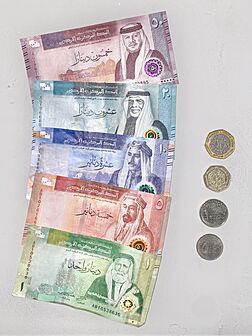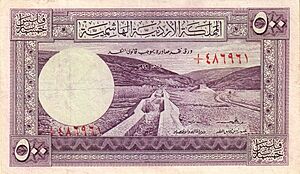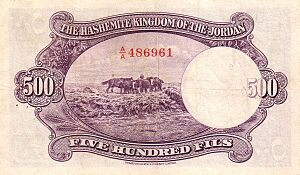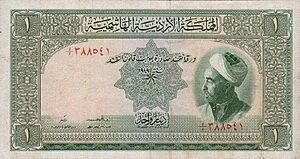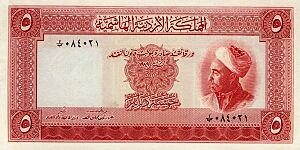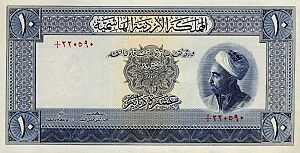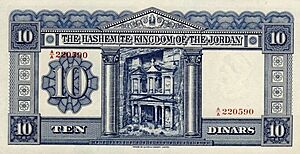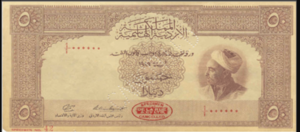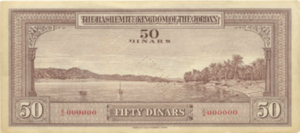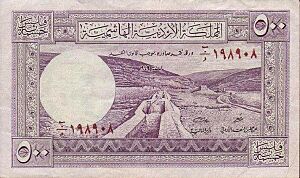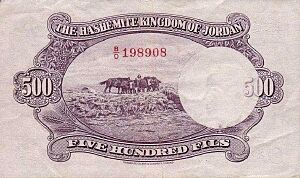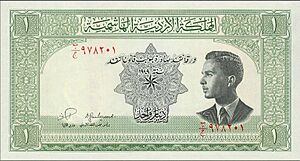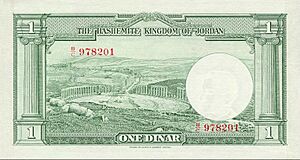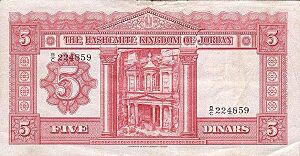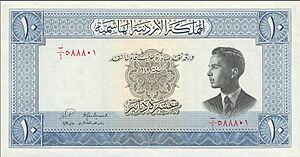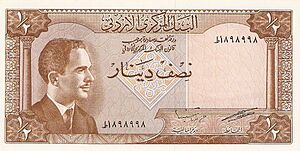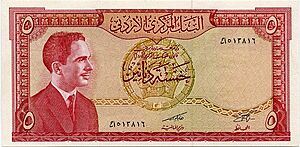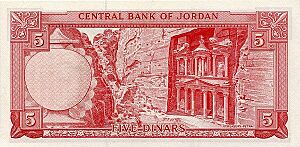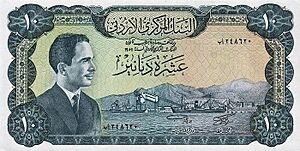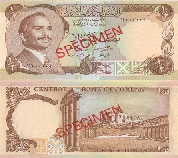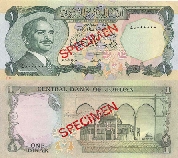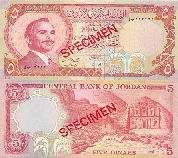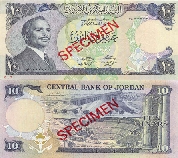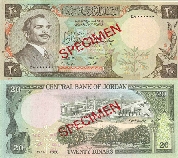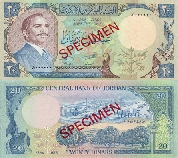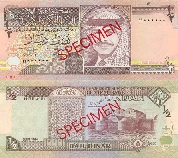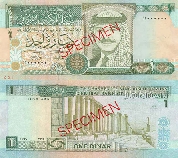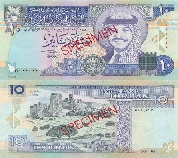Jordanian dinar facts for kids
Quick facts for kids Jordanian dinar |
|||
|---|---|---|---|
|
|||
| ISO 4217 Code | JOD | ||
| Official user(s) | |||
| Unofficial user(s) | |||
| Inflation | 1.35% | ||
| Source | The World Factbook, 2021 est. | ||
| Pegged with | US dollar US$ = JOD 0.708 (buy) US$ = JOD 0.71 (sell) |
||
| Subunit | |||
| 1⁄10 | dirham | ||
| 1⁄100 | qirsh or piastre | ||
| 1⁄1000 | fils | ||
| Symbol | د.أ | ||
| Coins | 1, 5, 10 piastres/qirsh, 1⁄4, 1⁄2 dinar | ||
| Banknotes | 1, 5, 10, 20, 50 dinars | ||
The Jordanian dinar (Arabic: دينار أردني) is the money used in Jordan. Its official code is JOD, but people often call it JD. Jordan has been using the dinar since 1950. One dinar is split into 100 qirsh (also called piastres) or 1000 fils. Even though fils aren't used much anymore, money amounts are still sometimes written with three decimal places to show fils. The Jordanian dinar is also used a lot in the West Bank, along with the Israeli shekel.
The Central Bank of Jordan started working in 1964. It became the only place allowed to print Jordanian money. Before that, another group called the Jordan Currency Board did this job.
Contents
History of the Jordanian Dinar
Before the Jordanian dinar, people in Jordan used the Palestine pound. This was set up in 1927 by the British who were in charge of the area at the time. It was used in both Mandatory Palestine and the area that would become Jordan.
Jordan became an independent country in 1946. But it kept using the Palestine pound for a little while longer. In 1949, Jordan created its own money system. They set up the Jordan Currency Board to print the new Jordanian dinar. This new money was worth the same as the Palestine pound.
The Jordanian dinar officially became Jordan's money on July 1, 1950. The Palestine pound stopped being used in Jordan by September 1950. In 1959, the Central Bank of Jordan was created. It took over printing money in 1964. Even when Jordan lost control of the West Bank in 1967, the Jordanian dinar continued to be used there. It is still widely used in the West Bank today.
Coins of Jordan
Coins were first made in 1949. They came in values like 1, 5, 10, 20, 50, and 100 fils. Later, in 1968, 25 fils coins were made. In 1970, 1⁄4 dinar coins were introduced. The 1 fils coin was last made in 1985.
In 1996, smaller 1⁄4 dinar coins were made. New 1⁄2 and 1 dinar coins also came out. Until 1992, the coins had Arabic names like fils, qirsh, dirham, and dinar. But in English, they only showed fils and dinar. Since 1992, the Arabic names fils and dirham are not used on coins. The English names are now dinar, qirsh, or piastres.
Today, the coins used are:
- 1 qirsh
- 5 piastres (qirsh)
- 10 piastres (qirsh)
- 1⁄4 dinar
- 1⁄2 dinar
Banknotes of Jordan
The Central Bank of Jordan is the only place that prints Jordanian banknotes. It started releasing its first series of notes on August 4, 1965. Before 1965, the Jordan Currency Board printed the money. And before 1949, the Palestinian pound was used.
In 1949, the Jordan Currency Board printed banknotes in values of 1⁄2, 1, 5, 10, and 50 dinars. These notes had the country's official name: "The Hashemite Kingdom of the Jordan." In 1977, 20 dinar notes were added. The 50 dinar note was updated, and the 1⁄2 dinar notes were replaced by coins in 1999.
Early Banknotes (1949–1965)
These banknotes were issued by the Jordan Currency Board.
First Issue (1949–1952)
| Obverse | Reverse | Value | Dimensions | Primary Color | Obverse Picture | Reverse Picture | Printed Date |
|---|---|---|---|---|---|---|---|
| 500 fils | 128 x 76 mm | Dark Purple | Wadi Al Arab Irrigation Project | Shepherd with his flock | 1949 (Gregorian)
1368 (Hijri) |
||
| 1 dinar | 160 x 86 mm | Green | King Abdullah I | Oval Plaza - Jerash | |||
| 5 dinar | 169 x 88 mm | Red | View of Al-Khazneh | ||||
| 10 dinar | 185 x 97 mm | Blue | |||||
| 50 dinar | 190 x 100 mm | Brown | View from Aqaba |
Second Issue (1952–1965)
| Obverse | Reverse | Value | Dimensions | Primary Color | Obverse Picture | Reverse Picture | Printed Date |
|---|---|---|---|---|---|---|---|
| 500 fils | 128 x 76 mm | Dark Purple | Wadi Al Arab Irrigation Project | Shepherd with his flock | 1952 (Gregorian)
1371 (Hijri) |
||
| 1 Dinar | 160 x 86 mm | Green | King Hussein bin Talal | Oval Plaza - Jerash | |||
| 5 Dinar | 169 x 88 mm | Red | View of Al-Khazneh | ||||
| 10 Dinar | 185 x 97 mm | Blue |
Banknotes by the Central Bank of Jordan
These banknotes were issued by the Central Bank of Jordan.
First Issue (1965–1975)
| Obverse | Reverse | Value | Dimensions | Primary Color | Obverse Picture | Reverse Picture | Issue Date |
|---|---|---|---|---|---|---|---|
| 1⁄2 dinar | 140 x 70 mm | Dark Orange | King Hussein bin Talal | Oval Forum - Jerash | August 4,
1965 |
||
| 1 dinar | 150 x 75 mm | Green | Dome of the Rock | August 4, 1965 | |||
| 5 dinar | 164 x 82 mm | Red | View of Al-Khazneh | August 4, 1965 | |||
| 10 dinar | 175 x 88 mm | Blue | Al-Maghtas | August 4, 1965 |
Second Issue (1975–1992)
| Obverse/Reverse | Value | Dimensions | Primary Color | Obverse Picture | Reverse Picture | Issue Date |
|---|---|---|---|---|---|---|
| 1⁄2 dinar | 136 × 67.5 mm | Brown | King Hussein bin Talal | Oval Forum - Jerash | November 16, 1975 | |
| 1 dinar | 144 × 71.5 mm | Green | Dome of the Rock | November 16, 1975 | ||
| 5 dinar | 152 × 76 mm | Red | View of Petra | November 16, 1975 | ||
| 10 dinar | 160 × 80 mm | Dark Purple | The Cultural Palace at Al-Hussein Youth Sports City Roman Amphitheater (Amman)
Three Roman columns in Jerash |
November 16, 1975 | ||
| 20 dinar | 168 × 84 mm | Olive Green/Blue | View of the Al-Hussein Thermal Power Station in Zarqa
Olive grove |
June 3, 1978 (Olive Green)
August 25, 1990 (Blue) |
Third Issue (1992–2002)
| Obverse/Reverse | Value | Dimensions | Primary Color | Obverse Picture | Reverse Picture | Issue Date |
|---|---|---|---|---|---|---|
| 1⁄2 dinar | 131 × 62 mm | Brown | King Hussein bin Talal | Qusayr 'Amra | August 1, 1992 | |
| 1 dinar | 137 × 66 mm | Green | The Cardo in Jerash | |||
| 5 dinar | 143 × 70 mm | Red | Al-Khazneh | October 1, 1992 | ||
| 10 dinar | 149 × 74 mm | Blue | Ajloun Castle | |||
| 20 dinar | 155 × 78 mm | Olive green and gray | Dome of the Rock | August 1, 1992 |
Fourth Issue (2002–2022)
| Obverse | Reverse | Value | Dimensions | Main Color | Obverse Picture | Reverse Picture | Printed Date | Issued Date | Watermark |
|---|---|---|---|---|---|---|---|---|---|
 |
 |
1 dinar | 133 × 74 mm | Green |
|
|
2002 Hijri 1423 |
March 30, 2003 | Sharif Hussein bin Ali |
 |
 |
5 dinars | 137 × 74 mm | Brick orange |
|
|
December 22, 2002 | Abdullah I bin al-Hussein | |
 |
 |
10 dinars | 141 × 74 mm | Blue |
|
|
Talal bin Abdullah | ||
 |
 |
20 dinars | 145 × 74 mm | Brown and Olive Green |
|
February 2, 2003 | Hussein bin Talal | ||
 |
50 dinars | 149 × 74 mm | Brown and Purple |
|
Abdullah II bin al-Hussein |
Fifth Issue (2022–present)
| Obverse | Reverse | Value | Dimensions | Main Color | Obverse Picture | Reverse Picture | Printed Date | Issued Date | Watermark |
|---|---|---|---|---|---|---|---|---|---|
 |
 |
1 dinar | 133 × 74 mm | Green |
|
|
2022 Hijri 1443 |
26 December 2022 | Sharif Hussein bin Ali |
 |
 |
5 dinars | 137 × 74 mm | Orange | Treasury, Petra | 16 August 2023 | Abdullah I bin al-Hussein | ||
 |
 |
10 dinars | 141 × 74 mm | Blue | Roman Theater in Amman | 26 July 2023 | Talal bin Abdullah | ||
 |
 |
20 dinars | 145 × 74 mm | Cyan |
|
Wadi Mujib | 21 March 2023 | Hussein bin Talal | |
 |
 |
50 dinars | 149 × 74 mm | Purple | Wadi Rum | 5 February 2023 | Abdullah II bin al-Hussein II |
How the Dinar's Value Stays Fixed
Since October 23, 1995, the Jordanian dinar has been officially "pegged" to the IMF's special drawing rights (SDRs). This means its value is tied to a mix of other major currencies.
In simple terms, the dinar's value is mostly fixed to the U.S. dollar. For a long time, 1 U.S. dollar has been worth about 0.709 Jordanian dinars. This means 1 Jordanian dinar is worth about 1.41 U.S. dollars. The Central Bank of Jordan buys U.S. dollars at 0.708 dinar per dollar and sells them at 0.710 dinar per dollar. This helps keep the dinar's value stable.
Here's how the dinar's value compared to the U.S. dollar over some years:
| Year | US Dollar = |
|---|---|
| 1980 | 0.29 dinar |
| 1985 | 0.39 dinar |
| 1990 | 0.66 dinar |
| 1995 | 0.70 dinar |
| 2020 | 0.71 dinar |
See also
- British currency in the Middle East
- Economy of Jordan
- Economy of the Palestinian territories
- Iraqi dinar


